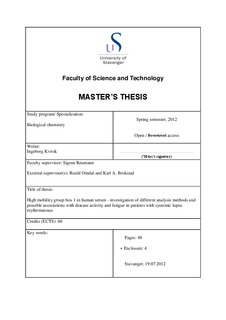| dc.contributor.author | Kvivik, Ingeborg | |
| dc.date.accessioned | 2013-01-16T13:13:11Z | |
| dc.date.available | 2013-01-16T13:13:11Z | |
| dc.date.issued | 2012 | |
| dc.identifier.uri | http://hdl.handle.net/11250/182476 | |
| dc.description | Master's thesis in Biological chemistry | no_NO |
| dc.description.abstract | The High mobility group box 1 (HMGB1) protein is a DNA-binding protein mainly located in the nucleus of cells. It can be passively or actively released to the extracellular environment in necrotic cells or activated cells in the innate immune system. Extracellular HMGB1 functions as a proinflammatory molecule and is important for activation of the innate immune system, acting alone or in complex with other molecules such as interleukin-1β, lipopolysaccharide and DNA. In cytosol HMGB1can bind foreign nucleic acids and enhance signalling through damage associated molecular pattern (DAMP) receptors, activate the innate immune system, and induce production of type I interferons, proinflammatory cytokines and chemokines.
Due to its strong proinflammatory properties, HMGB1 is a mediator of several different inflammatory diseases including rheumatoid arthritis, sepsis and autoimmune diseases such as primary Sjögren's syndrome and systemic lupus erythematosus (SLE).
Measuring HMGB1 in serum has proven to be difficult due to its “sticky nature”, i.e. its ability to form complexes with other molecules. Also, anti-HMGB1 antibodies both in sera from healthy people and patients with SLE confer difficulties. The place for the HMGB1 enzyme-linked immunosorbent assay (ELISA) has therefore been questioned. Treating serum with perchloric acid (PCA) prior to the ELISA analysis has been proposed as interference modification to remove proteins, complexes and antibodies from the HMGB1 molecule itself.
The aim of this study has been to investigate available methods for HMGB1 analysis, including the PCA-ELISA, and to establish a valid and reliable assay for analyses of human sera. The methods have been applied to sera from SLE patients and healthy control subjects and HMGB1 levels have been associated with levels of disease activity and fatigue.
Our results show that serum HMGB1 concentrations measured with a conventional ELISA do not correlate with immunoblot results and the PCA-ELISA method do not improve the conventional ELISA. The preferred method for serum HMGB1 analysis is the immunoblot method.
HMGB1 levels were in our study not associated with SLE disease activity, but patients with high HMGB levels had more fatigue than those with low levels. This indicates a possible association between serum HMGB1 and fatigue in SLE patients. | no_NO |
| dc.language.iso | eng | no_NO |
| dc.publisher | University of Stavanger, Norway | no_NO |
| dc.relation.ispartofseries | Masteroppgave/UIS-TN-IMN/2012; | |
| dc.subject | biologisk kjemi | no_NO |
| dc.title | High mobility group box 1 in human serum - investigation of different analysis methods and possible associations with disease activity and fatigue in patients with systemic lupus erythematosus | no_NO |
| dc.type | Master thesis | no_NO |
| dc.subject.nsi | VDP::Mathematics and natural science: 400::Basic biosciences: 470::Molecular biology: 473 | no_NO |
| dc.subject.nsi | VDP::Mathematics and natural science: 400::Basic biosciences: 470::Biochemistry: 476 | no_NO |
| dc.source.pagenumber | 61 | no_NO |
